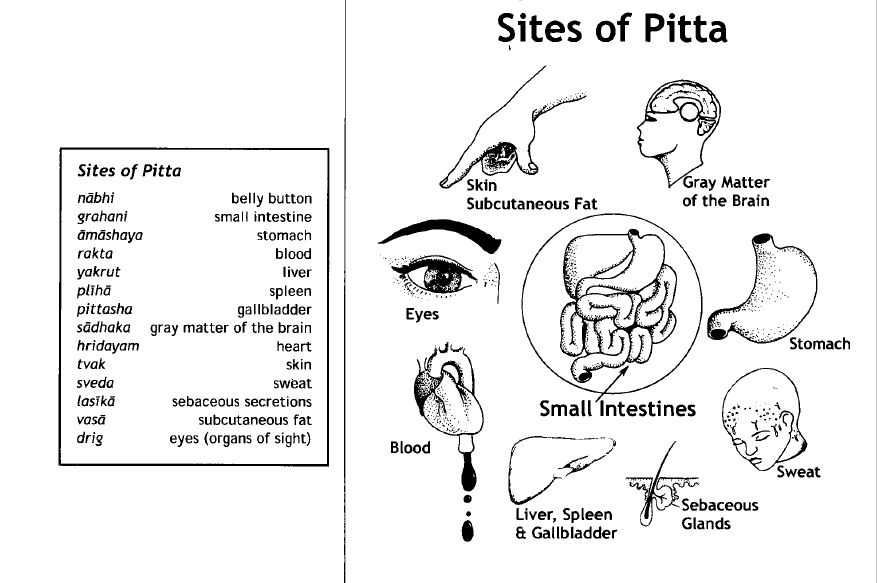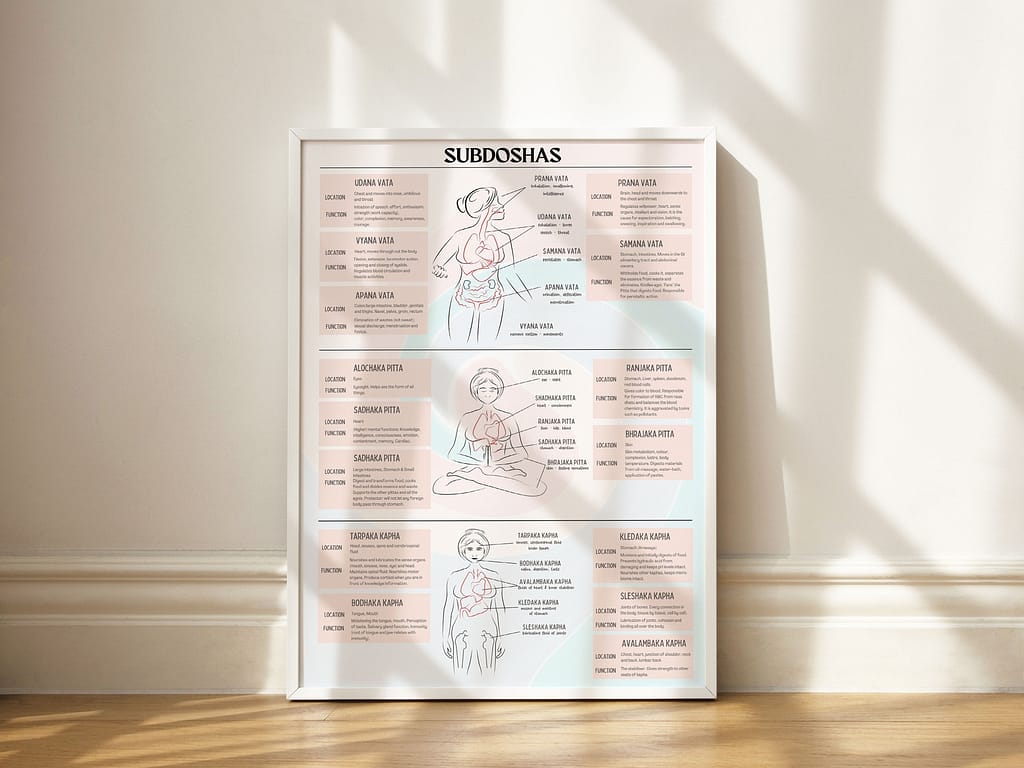The word ‘pitta’ represents heat, fire or agni. Pitta dosha is a combination of fire and water element in the body. It is responsible for change and transformation. Pitta dosha is dominant in the stomach, liver, spleen, gall bladder, small intestines, eyes, blood, pancreas, sweat and sebaceous secretions. When we eat food, the process digestion, absorption and assimilation is governed by pitta.
In one of the previous articles, we discussed about the subtypes of Vata dosha. Similar to that there are also 5 subtypes of pitta dosha namely pachaka pitta, ranjaka pitta, bhrajaka pitta, alochaka pitta and sadhaka pitta. Lets discuss why they exist and what are their functions in the body.

Pachaka Pitta
Pachaka pitta is present in the stomach and small intestines. The function of pachaka pitta is to digest, absorb and assimilate as soon as the food enters the stomach. The food digested in the stomach is further digested with the digestive juices secreted in the small intestines. Pachaka pitta in the stomach is part of jathara agni (central gastric fire or the main agni of the body). It includes secretions of hydrochloric acid and digestive enzymes.
Pachaka pitta inside the small intestines breaks down the food further so that the blood vessels underneath the villi can absorb the nutrients. The nutrients which were absorbed are moved in general circulation.
An imbalance in pachaka pitta can create problems like sugar cravings, hypoglycaemia, hyperacidity, heartburn, malabsorption, gastritis, indigestion, peptic ulcer, anorexia and dyspepsia.

Ranjaka Pitta
Ranjaka (Sanskrit meaning ‘giving colour’) pitta is located mainly in the liver and spleen. It gives colour to every tissue.
Ranjaka pitta is responsible for Erythropoiesis or manufacturing of haemoglobin and RBC (red blood cells). According to the descriptions in Ayurvedic samhita, the rasa dhatu which is pale in colour is converted to rakta dhatu by ranjaka agni or fire of the ranjaka pitta. It gives the blood its red colour. In the featal life, liver and speel are the main organs responsible for this action, but in grown human beings, stomach (amashaya) is also very much involved in the action of erythropoiesis.
An imbalance in ranjaka pitta can create problems like hepatisis, anemia, chronic fatigue syndrome and mononucleosis. When kapha disturbs ranjaka pitta, the person may develop gallstones. If kapha is long-standing and lingers in the liver, the person may develop high cholesterol, fatty degeneration of the liver, or steatorrhea (fatty diarrhoea).
Bhrajaka Pitta
The main site for Bhrajaka pitta is tvak which means skin. It is not just the outside skin that we can see but also the dermal layer, epidermal layer, mucus layer, and all covering of organs. A good bhrajaka pitta gives good colour, complexion, texture and lustre to the skin. It also gives temperature to the skin.
The fire component of brajaka pitta is called bhrajaka agni. It is responsible for sensations of touch, pain, temperature and stereognosis (touch with depth and quality perception). It also digests whatever is applied on the skin eg. oils, medicated preparations, powder or paste treatments etc.
An imbalance of bhrajaka pitta can create diseases of skin eg psoriasis, eczema, dermatitis, anesthesia, acne etc.
Alochaka Pitta
Alochaka pitta is the pitta present in the eyes. It governs colour, lustre, optical perception (2 and 3 dimensional), color and light vision. When combined with prana, it gives the ability to focus.
Alochaka pitta is also associated with emotions. Different emotions bring a different chemistry to the tears.
An imbalance of bhrajaka pitta can create diseases of eyes like myopia, hypermetropia, conjunctivitis, styes, iritis, photophobia (light sensitivity), burning sensation in the eye.
Sadhaka Pitta
Sadhaka pitta is located in the brains grey matter as neurotransmitters, the heart and throughout the nervous system. It is responsible for giving rise to Ahamkara or ego. Due to this type of pitta, a person is able to understand, comprehend, obtain knowledge. It transforms sensations into feelings and emotions. It gives self confidence, self esteem and ego.
It also perceives sound and converts it to nervous impulses which we understand and digest. It is also reponsible for memory and intellect. Sadhaka pitta in the heart metabolizes and processes feelings and emotions.
An imbalance in sadhaka pitta creates delusions, confusion, unwillingness to do things, lack of will and appreciation, fatigue, loss of motivation, poor memory, emotional volitility, psychosomatic disorders and heart diseases.
| Types of Pitta | Seat | Function |
|---|---|---|
| Pachaka Pitta | Stomach and small intestines | Digest, absorb and assimilate food. |
| Ranjaka Pitta | Liver, Spleen, Stomach | Erythropoiesis or manufacturing of haemoglobin and RBCs. |
| Bhrajaka Pitta | Skin and covering for all organs | Gives good colour, complexion, texture, temperature and lustre to the skin. |
| Alochaka Pitta | Eyes | Governs colour, lustre, optical perception, light vision. Gives ability to focus. |
| Sadhaka Pitta | Brain, Heart, Nervous System | Helps in understanding, comprehending, gaining knowledge, metabolises and processes feelings and emotion. |
Did you find this post useful? Would you like to get back to it later? Save THIS PIN below to your Pinterest Natural Living or Ayurveda board!

